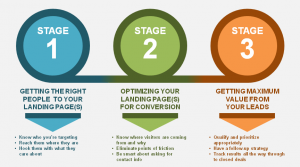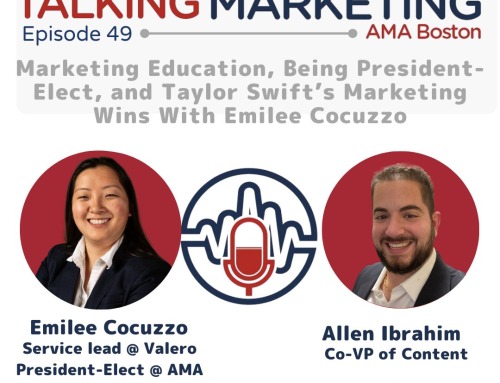Want more quality leads? Who doesn’t?
Broadly speaking, B2B lead gen encompasses three stages of activity: attracting the right audience(s), getting them to provide information about themselves, and then ushering them through the sales process to closed deals (assuming that’s your primary goal). But while the objective of each stage is pretty straightforward, its execution is not. There are a lot of moving parts, and many opportunities for prospects to drop out along the way. The more “leaks” you have across your lead gen operation, the harder it will be to bring in the quality leads you need to hit the most important goal of all: revenue.
Stage 1: Getting the Right People to Your Landing Page(s)
It’s easy to capture just anyone’s attention—for the price of a t-shirt or gift card, you can buy your way to pure volume. But that will only get you names. To get leads with real revenue potential, you need to:
Know who you’re targeting. It sounds obvious, but if you haven’t done the work to define and really understand your audience(s), it’ll be that much harder to find and engage them. Personas can be helpful, but make sure they focus on what matters. Giving your persona a name, age, salary, and so on, is far less important than identifying key characteristics such as challenges they face, how they make or influence purchasing decisions, where they get information from, etc.
Pro tip: Sales and marketing must be aligned on who to target. Whether you use formal personas or just simple descriptions of your target market, do work with the sales team to create those definitions.
Reach them where they are. Your target audience will determine which channels to use for your marketing programs. Selecting the right mix takes a combination of research and common sense. For example, if no one is searching for a product like yours—maybe it’s a new solution to a problem that people don’t even realize they have—then Google AdWords may not be an appropriate tactic right now. If one target segment spends a lot of time on Twitter and LinkedIn but another is pretty much only on LinkedIn, calibrate your social program accordingly. While you don’t want to invest in channels that aren’t relevant to your particular audience(s), you do want to be on as many relevant ones as possible. Visibility across multiple channels creates repetition and consistency, which is a good thing.
Pro tip: Don’t be afraid to simply ask your customers about which channels they use. And review the mix on a periodic basis as usage and preferences do evolve over time.
Hook them with what they care about. Once you’ve found the right people in the right places, you need to engage their interest. And unless there is an opportunity to convert them where they are (which is ideal), you need to entice them to your own website. They’re not going to come just because you ask them to. You have to give them something they find valuable, such as information that helps them solve a problem or do a better job, or if they are actively looking to buy, perhaps a free trial or demo.
Pro tip: Test your messages and offers to learn what resonates. And test per channel as what works in one may not be as effective in another.
Stage 2: Optimizing Your Landing Page(s) for Conversion
It’s not enough to get your target audience to your website—you want them to convert. For most B2B companies, this usually means filling out a form in exchange for a piece of content, requesting a demo or sales consultation, or downloading a trial. To maximize your conversion rate:
Know where visitors are coming from and why. It’s tempting to find an existing page on your website to use as a landing page for your campaigns, but you must resist that temptation. When you run programs designed to drive visitors to your site, you know exactly where they are coming from and why they are visiting. And since you control which page they’ll land on first, use that context to create a consistent experience. Yes, that may mean managing multiple similar landing pages which does take extra work, but if that effort increases your flow of high-quality leads, it’s very much worth it.
Pro tip: If you do build multiple landing pages that are very similar, you should use canonical URLs to prevent the SEO issue of duplicate content. (If you want to learn more about canonicalization, check out this great video from Moz.)
Eliminate points of friction. Visitors aren’t willing to expend a lot of time and effort. The path between arriving on the page and clicking the “submit” button must be as easy as possible. Think through and mitigate all the potential barriers to conversion; they are wide-ranging and can include:
- The overall design (including visual triggers), imagery, and messaging
- How much text is on the page and how it’s formatted
- How prominent the call to action is on the page
- How many links there are on the page that could lead visitors away before they take the desired action
- What objection-handling (or action-inducing) copy needs to be included
- How many form fields are included, and how many are required• What copy to use for the submit button (hint: it’s not “submit”)
Pro tip: When it comes to building landing page templates in your CMS, don’t over-templatize them. You need the flexibility to move elements around so you can build a landing page based on what works, not on what the template allows you to do.
Be smart about asking for contact info. First, you need to decide which details to ask for, and that should be commensurate with what the visitor gets in return. The more high-value the offer (from their perspective, not yours), the more you can require. Progressive profiling is a good way to keep any one form short but build out the details of a prospect over time as they continue to engage. And using cookies to pre-fill the form with data you already know about the prospect reduces the amount of work they need to do. Second, you need to determine how to ask visitors for their information. You can use a basic in-page form, but explore other form types, such as multi-step forms or scroll-, time- or exit-triggered popups.
Pro tip: Just as you need to test the offers and messaging that get your visitors to the landing page, you need to test the elements of the landing page—especially the form—to understand what will maximize conversions. Conventional wisdom can be wrong, so test everything, including form type, length, position on the page, design, copy, etc.
Stage 3: Getting Maximum Value from Your Leads
As a marketer, your goal is to bring in quality leads. But leads aren’t the end game—you need those leads to turn into business, and it’s not enough to just hand them over to sales and call it a day. Marketing continues to play an important role in getting business value from the leads it brings in. This means you need to:
Qualify and prioritize appropriately. Not all leads are created equal. You’re always hoping for hot leads that are ready to buy now, but most will not fall into that category. Some will be very good leads that aren’t ready to buy just yet but will be in the foreseeable future, some will be junk, and the rest will fall somewhere in between. You need a way to efficiently qualify your leads so you know the best next step to take with each.
Pro tip: There are lots of ways to score leads, but no matter what qualification approach you use, you must work with the sales team to define what “qualified” means, as well as what the lead workflow process will look like.
Have a follow-up strategy. You’ll notice that I called it a strategy and not a process. That’s because follow-up should depend on how the leads have been qualified and prioritized (see above). Some leads should go directly to sales for immediate follow-up. Others may go into a nurture program—and you may need different nurture streams for different types of leads. Every lead that has some potential, whether that’s in the short or long term, needs some kind of follow-up. Once you have the strategy, you can define the specific processes for execution. And again, it should be a collaboration with sales.
Pro tip: Don’t think of lead nurturing as simply a marketing-driven program. Provide the sales team with opportunities to reach out to the contacts they’re working. For example, if you have a new white paper (or case study, or blog post) that speaks to a particular audience, draft a short email that reps can send as a personal “I thought you might find this valuable” note to relevant contacts. It keeps you top of mind without being salesy.
Track results all the way through to closed deals. As marketing and sales automation tools have gotten more sophisticated, it’s easier than it used to be to track attribution, though it still isn’t easy. Some organizations do it very well but others are still struggling to make it happen. It’s imperative to understand how your lead gen programs drive revenue. Total number of leads generated and number of SQLs handed over to sales are important metrics, but they simply aren’t enough. In the end, if all those leads don’t turn into revenue, it doesn’t really matter. You don’t have to get there all at once. Start with the current level of attribution and focus on making the link to just the next step. Then take the next step after that. Then the next. A slow-and-steady progression beats ignorance every time.
Pro tip: In addition to tracking leads through the entire sales process, you should also know the average conversion rates between each major stage in the process, e.g., percent of raw leads that become MQLs, MQLs that become SQLs, SQLs that become opportunities, etc. Look for weak conversion points—those are leaks—so you can figure out what’s going wrong and fix it. Identify programs or lead sources that beat your averages (do more of that) and those that underperform (reduce those investments or make changes).
 Keep Your Lead Gen Ship Sailing Smoothly
Keep Your Lead Gen Ship Sailing Smoothly
Generating a constant stream of quality leads is hard work. If you’re not vigilant, leaks can spring up anywhere in the process, making your job even harder than it has to be. Whether you’re just building a lead gen engine or have a mature operation, it’s worth reviewing what you’re doing at every stage so you can find and fix any leaks you may have.







